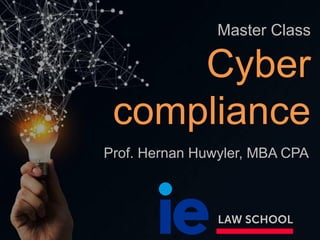
Master Class Cyber Compliance
- 1. Master Class Cyber compliance Prof. Hernan Huwyler, MBA CPA
- 2. IE, top worldwide MBAs
- 3. Support IT in embedding compliance controls Challenge
- 4. There is not security in IT security Compliant but unprotected No framework is 100% breach-free Challenge
- 6. 1st Line IT Process and Contract Mgrs Governance 2nd Line Compliance Privacy, risks, info sec 3rd Line IT Audit
- 7. Implement a mobile and endpoint device management Work-from-Anywhere
- 8. Enhance requirements for cloud and eCommerce service providers Cloud and eCommerce
- 9. Audit internal and 3P controls against ransomware and spearphishing Privacy enforcement
- 10. Compliance register Control matrix Policies and procedures IT contracts End-to-end scope 1
- 12. Create simple policies to buy software and an inventory of applications to prevent shadow IT Licensing Compliance 2
- 13. Implement a monthly reconciliation between the software inventory and the paid licenses Licensing Compliance 2
- 14. Implement and train simple policies to buy and approve software by the CISO to prevent shadow IT Licensing Compliance 2
- 15. Block accesses to rogue or risky cloud services sites (e.g. Dropbox, Google Docs) Licensing Compliance 2
- 16. Request to use probabilistic methodologies to quantify IT risks Corporate defense 3
- 17. Request to use probabilistic methodologies to quantify IT risks Corporate defense 3
- 18. Strength the scientific basis to invest (or not!) on data security controls for contractual, privacy and corporate criminal laws Corporate defense 3
- 19. “appropriate and proportionate technical and organisational measures” Corporate defense 3
- 20. The paucity of legal opinion addressing Monte Carlo techniques gives one pause at suggesting that Monte Carlo simulation will ever be challenged, much less successfully, on judicial review. Judges will likely be disinclined to delve into their intricacies, likely characterized as technical and scientific and subject to a longstanding judicial deference.” Susan Poulter Corporate defense 3
- 21. IT compliance register 4 GDPR, eCommerce directive Computer crime for corporate criminal responsibility IT services, licenses, and outsourcing contracts Sectorial regulations for essential services
- 22. Dumpster diving 5 Ensure physical documents and drives are safely destroyed
- 23. Ensure how backups are done and retain for data in the cloud Due diligence for cloud
- 24. Ensure who has access to the data in the cloud application Due diligence for cloud
- 25. Security settings in the cloud app are aligned to the internal policies Due diligence for cloud
- 26. Undestand the locations of the data in transit and at rest for privacy Due diligence for cloud
- 27. Request to separate company data from the cloud application to minimize risks Due diligence for cloud
- 28. Checklist model https://www.microsoft.com/en/trust- center/compliance/due-diligence-checklist Due diligence for cloud
- 29. Due diligence for cloud
- 30. Operators of essential services should have risk-based IT and compliance controls with international standards NIS Directive
- 31. Operators of essential services should detect and report securitity breaches without undue delay NIS Directive
- 33. Ensure clients read and accept the privacy policy before they provide personal data eCommerce compliance
- 34. Ensure customers are informed about the uses of the cookies eCommerce compliance
- 35. Verify that delivery periods, payment methods and cancellation options are communicated eCommerce compliance
- 36. Control that the clients can correct and accept the order in local language eCommerce compliance
- 37. Verify that prices include clear shipping costs and taxes eCommerce compliance
- 38. Monitor contracts and license payments for used software Computer crime
- 39. Protect the intellectual property of 3rd parties by employees and contractors Computer crime
- 40. Prevent and detect installed software for fraud and hacking abuse Computer crime
- 41. Computer crime
- 42. Data loss prevention tools prevent exfiltration with forensic evidence Tools
- 43. Secure email gateways can filter bulk phishing emails Tools
- 44. A data classification policy can ensure compliance while preventing risks Tools
- 45. eDiscovery helps to review the record of processing activities for GDPR compliance Tools
- 47. Our modular program Compliance Culture Compliance risks Program operations Privacy compliance Control assurance Blended
- 48. Our
- 49. Case method
